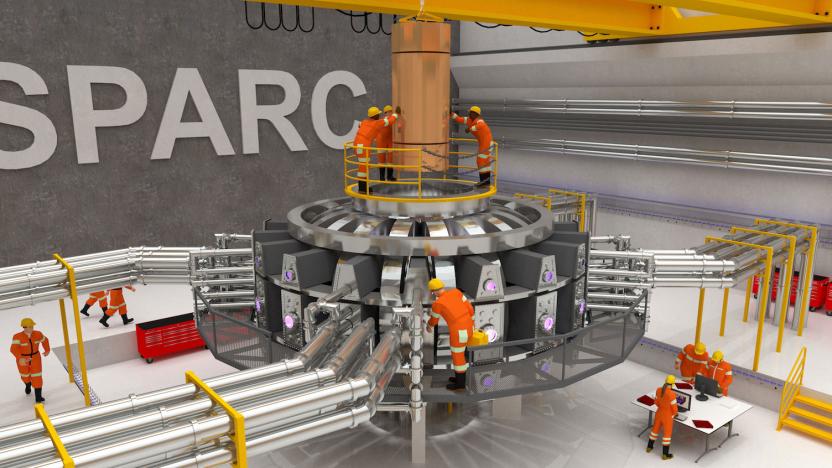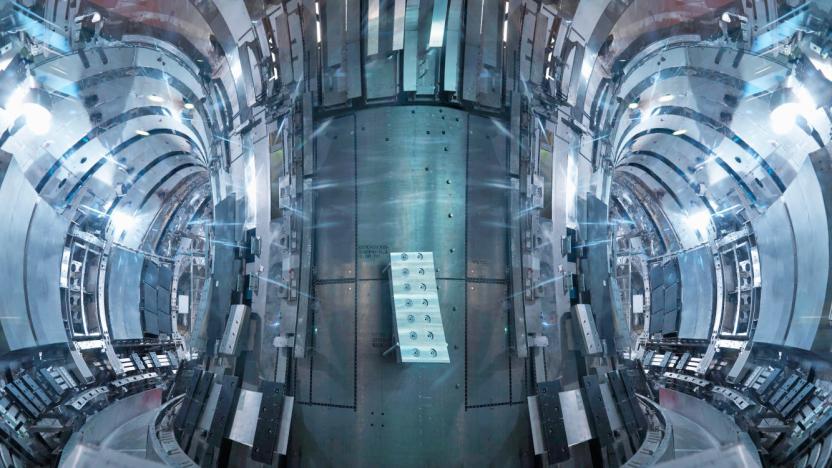TL18FUSE
Latest

MIT embarks on ambitious plan to build nuclear fusion plant by 2033
MIT announced yesterday that it and Commonwealth Fusion Systems -- an MIT spinoff -- are working on a project that aims to make harvesting energy from nuclear fusion a reality within the next 15 years. The ultimate goal is to develop a 200-megawatt power plant. MIT also announced that Italian energy firm ENI has invested $50 million towards the project, $30 million of which will be applied to research and development at MIT over the next three years.

Quark fusion makes ten times as much energy as nuclear fusion
Scientists have overcome huge barriers in the past year to get us even closer to nuclear fusion, and with it a near-limitless supply of clean energy. But, what if there's something far more powerful out there? According to researchers at Tel Aviv University and the University of Chicago, there is, and it involves the fusion of elementary particles known as quarks -- the resulting energy from which would be ten times that of nuclear fusion.

Researchers create a new fusion recipe that boosts energy output
Nuclear fusion is an attractive way to create energy. It generates hardly any waste, doesn't pollute the planet and takes advantage of elements that we have plenty of. But fusion takes a lot of work and the energy payout isn't yet at the level that makes it suitable for producing power. But researchers at MIT have developed a new fusion recipe that boosts energy production by ten-fold.

Scientists may have solved a key barrier to fusion power
We've been working towards nuclear fusion, a near-limitless source of clean energy, for the past six decades, and now scientists have made a major breakthrough. A new article published in Physical Review Letters details how to solve a dangerous issue with runaway electrons that has, until now, posed a major problem for fusion reactors.

New magnetic field theory gets us closer to nuclear fusion
Researchers from the US Department of Energy (DoE) and Princeton University have developed a new theory on plasma that could help scientists figure out solar flares and fusion power. Most fusion research is focused on "magnetic confinement" reactors that use powerful magnets to fuse hydrogen plasma into helium. One of the biggest problems with that technique is that the plasma itself spawns new magnetic fields, which play havoc with the reactions.

Scientists get meaningful energy from laser-based nuclear fusion
Researchers have long sought to generate significant energy from laser-based nuclear fusion, and it appears that they're finally making some headway. Lawrence Livermore National Laboratory reports that laser blasts in September and November produced more energy from hydrogen fusion reactions than they'd put into the hydrogen -- the first time that's happened. The key was an extra dose of caution. The lab team altered the laser pulse so that it didn't break a shell used in the necessary fuel-compression process, improving the energy yield. We're still far from seeing laser fusion reactors when just 1 percent of the power reached the hydrogen in the first place. However, the output was much closer to what scientists have been expecting for years -- laser fusion is now more of a realistic possibility than a pipe dream. [Image credit: Dr. Eddie Dewald]

Nuclear fusion startup gets Jeff Bezos backing, won't be dropping any bombs
Here's a phrase we never though we'd utter: Bezos is the bomb! Okay, so maybe a nuke reference isn't exactly appropriate here, considering Jeff Bezos is actually backing a company that's looking to create cheap energy through nuclear fusion, but we couldn't resist. General Fusion, a nuclear fusion startup, released a statement today saying that it has completed a $19.5 million round of funding that included backing by the Amazon founder's Bezos Expeditions. According the company's website, General Fusion's approach to generating "safe and plentiful" energy employs a concept created about 30 years ago called "magnetic target fusion," and expects commercialization of its process could come before the end of the decade. Full PR after the break.

One megajoule laser brings nuclear fusion power closer to reality
When you think of the laser these days, you're most likely imagining a giant beam that can scorch a few buildings within seconds. Putting your evil thoughts aside, why not think smaller yet more powerful, and something that may change the future of mankind for good? We're talking about the National Ignition Facility that has recently produced the world's first megajoule laser, which only lasted for a few nanoseconds but is still a milestone for nuclear fusion development (read: clean energy on a massive scale). In a nutshell, this laser should be able to produce sufficient X-rays in order to fuse hydrogen nuclei, and it also has financial and efficiency advantage over other systems by having an exposed reactor core instead of one shielded by a huge magnet. That said, until the NIF tries the laser on fuel capsules this summer, we can only be hopeful. [Original photo from 2funnycats]

Detroit-area teen builds nuclear fusion reactor
We've heard of plenty of DIY projects, ranging from an MP3 player to a Wacom tablet, but a kid building a small nuclear fusion device in his parents' basement? That's something special. Thiago Olson, a 17-year-old from Oakland Township, outside Detroit, has just completed a 1,000-hour (that's over 40 days worth, but he spread it out over two years) project to build a small-scale nuclear fusion reactor. How does it work? The short of it is that Olson takes a vacuum chamber, fills it with deuterium gas and then jolts it up with 40,000 volts, which creates a very small amount of nuclear fusion. That sounds easy enough -- but now the question is, can young Dr. Strangelove hook up his reactor to the house so he can pay his parents' electrical bill? [Via MAKE: Blog, photo courtesy Detroit Free Press]






